Muscles Pain in the Lower Abdomen
What is the muscle pain in the lower abdomen?
Some people refer to abdominal muscle pain as aches or cramps in the stomach. the patient could feel this pain anywhere between the pelvis & the ribs region. Lower abdominal pain might arise between the pelvis & the belly button.
Most generally people find that their abdominal pain goes away on its own & does not last for a longer period. Generally, the reasons for abdominal pain are not so serious. Common causes include periodic pain, trapped wind, & urinary tract infections ( UTIs ).
Lower muscle abdominal pain has many possible causes. The more typical causes — such as indigestion, gas pains, or a pulled muscle — usually are not so serious. Other conditions may need urgent medical attention. While the location and pattern of lower abdominal pain could provide vital clues, its time course is useful when determining its cause.
Acute lower abdominal pain grows and often resolves over some hours to some days. Chronic lower abdominal pain may be episodic ( intermediate ), suggesting it may come & go. This pain may be present for weeks to months, or years. Some chronic conditions lead to progressive pain, which steadily gets worse over a long period.
What are the 4 types of abdominal pain?
The abdomen is home to organs, your healthcare provider might want to narrow down the kind of pain you’re having by narrowing down the area you’re feeling it in. The body often separates the abdomen into quadrants or four parts.
The pain is in which site:
- Right upper quadrant.
- Left upper quadrant.
- Right lower quadrant.
- Left lower quadrant.
Causes of lower abdominal muscle pain
The many conditions that lead to acute lower abdominal pain are generally accompanied by other symptoms that develop over hours to days and days to a year. Causes of lower abdominal pain could range from minor conditions that determine without any treatment to serious medical emergencies, including:
- Abdominal aortic aneurysm
- Abdominal muscle strain
- Appendicitis
- Cholecystitis
- Cystitis ( bladder inflammation )
- Cholangitis ( bile duct inflammation )
- Diverticulitis
- Duodenitis is the inflammation around the first part of the small intestine.
- Diabetic ketoacidosis
- Ectopic pregnancy, in which the fertilized egg implants and grows outside of the uterus, is known as a fallopian tube.
- Fecal impaction ( hardened stool that can not be stopped )
- Heart attack
- Injury
- Intestinal obstruction
- Intussusception ( in children )
- Kidney infection ( pyelonephritis )
- Kidney stones
- A liver abscess ( a pus-filled pocket in the liver region )
- Mesenteric ischemia means declined blood flow into the intestines.
- Mesenteric lymphadenitis means lymph nodes in the folds of the membrane that keep the abdominal organs in position )
- Mesenteric thrombosis means a blood clot in a vein carrying blood away from your intestines site
- Pericarditis means inflammation of the tissue around the heart organ
- Peritonitis is an infection of the abdomen
- Pleurisy means inflammation of the membrane surrounding the lungs area
- Pancreatitis
- Pneumonia
- Pulmonary infarction ( loss of blood flow to the lungs region )
- Ruptured spleen
- Salpingitis means inflammation of the fallopian tubes means
- Sclerosing mesenteritis
- Shingles
- Spleen infection
- A splenic abscess means a pus-filled pocket in the spleen organ
- Torn colon
- Urinary tract infection (UTI)
- Viral gastroenteritis ( stomach flu )
- Chronic ( intermittent, or episodic )
Common causes:
The most typical cause of chronic abdominal pain is often difficult to define. Symptoms may range from mild-severe, coming & going but not necessarily worsening over the period.
Conditions that might lead to chronic abdominal pain include:
- Angina (i.e.reduced blood flow to the heart)
- Celiac disorder
- Endometriosis
- Functional dyspepsia
- Gallstones
- Gastritis (i.e.inflammation of the stomach lining)
- Gastroesophageal reflux disease (GERD)
- Hiatal hernia
- Inguinal hernia
- Irritable bowel syndrome
- Mittelschmerz ( ovulation pain )
- Ovarian cysts
- Pelvic inflammatory disease (PID)
- Peptic ulcer
- Sickle cell anemia
- Strained or pulled abdominal muscle
- Ulcerative colitis means a type of inflammatory bowel disorder
Symptoms of lower abdominal muscle pain
Abdominal pain that slowly worsens over some time, usually accompanied by the result of other symptoms, is usually serious in the body.
Causes of progressive abdominal pain include:
- Cancer
- Crohn’s disease
- Enlarged spleen (splenomegaly)
- Hepatitis
- Kidney cancer
- Lead poisoning
- Liver cancer
- Non-Hodgkin’s lymphoma
- Pancreatic cancer
- Stomach cancer
- Gallbladder cancer
- A tube-ovarian abscess (pus-like formation -filled pocket involving a fallopian tube and an ovary)
- Uremia means the build-up of waste products in the human blood
you’ll experience this pain when, sneezing, coughing, or laughing.
Sprinting or doing energetic exercise.
Getting up after a prolonged period of sitting or inactivity position.
Other symptoms include:
- Abdominal pain
- Sudden sharp pain
- Stiff muscles
- Swelling
- Bruising
- Abdominal Muscle spasms or cramping
- The surface of the stomach region may feel tender and inflamed. You are more likely to feel these quiet feelings when you are contracting the abdominal muscles & moving the muscles.
- Weakness
- Trunk pain while exercising, laughing, sneezing, coughing
- The problem is doing activities and moving.
- Problem in breathing
Diagnosis of lower abdominal muscle pain
X-rays: X-rays help to check for ribcage injuries, spinal fractures, or other broken bones.
MRI to check muscles or another injury.
Treatment of lower abdominal muscle pain
Nonsurgical treatment
Nonsurgical, or conservative treatment maximum muscle strains don’t require surgery if the muscle is fully damaged doctors recommend surgery If there’s a partial gash also the athlete can replace it when they’re effortless & have normal strength & conditioning. This normally occurs following anywhere from some weeks to many months of important treatment and therapy. When the muscles are fully impaired, the athlete might be advantaged from surgical repair. Tone the effort of a muscle strain in the body.
Some therapists recommend avoiding inimical pain medicines which will extend your threat of bleeding in the body, similar to over-the-counter ( OTC ) medicine [naproxen sodium (Aleve) ] aspirin & ibuprofen, Advil, Motrin IB, via the first 48 hours after muscle strain. Acetaminophen Tylenol et al. can be supported for pain comfort during this time.
Physiotherapy treatment
Initial phase
A physiotherapist could help you to enhance the strength & stability of the injured joint or limb. A physiotherapist might recommend that you simply stabilize with a brace. For a few muscle damages, abdominal sprint surgery might be called.
the R.I.C.E technique.
To stop swelling & pain as first aid by following RICE’s principal technique:
- R_Rest
- I_Ice for reducing swelling
- C_Compression tapping and splinting
- E_Elevation
- Beginning with the use of an ice pack for 20 minutes, then the ice pack is often reapplied every 2 hours for the first 2-3 days post-injury.
- Rest is another part of the R.I.C.E. principle but it’s a little more complicated with an abdominal strain. Injuries to the arms & legs could easily be protected and rested via the utilization of crutches, slings, or braces. However, splinting the trunk of the body is not such an effortless task.
- To protect and rest the abdominal muscle, the athlete might have limited movement for a few days til the pain reduces.
The purpose of activity treatment is:
- Decrease abdominal muscle pain
- Relieve muscle swelling
- Improves thigh muscle strength.
- Enhance full mobility of the ligament & related joints in the body
- Restore the patient’s entire functional movement
- Restore the patient’s confidence
Acute phase to 2 weeks after injury in lower muscles abdominal pain
Physiotherapy rehabilitation could be initiated after 48 hours of injury. For the first few days provide an electric modality give to relieve swelling & pain in decreasing.
Electrotherapy treatment
Ultrasound [ US ]: Ultrasound has been used for tissue recovery. Improves blood circulation & mobility. To decrease swelling & pain.
Cryotherapy: Inflammation & swelling could be relieved by applying cryotherapy in form of ice packs, & cold water baths to the impacted part. Continuous application of cold packs many times a day for 15 to 30 minutes at a time is suggested.
Transcutaneous electrical nerve stimulation ( TENS ): TENS might be able to assess and relieve pain & muscle spasms.
Exercise for lower abdominal muscles pain
- Heeltap
- Mountain climber
- Pelvic tilt
- Heel slides
- Twisting Sit-Ups
- Hip lift
- Abdominal curl-ups
- Scissor
- Slider pike
- Straight leg raise
- Crunches
- Cross-body climber
- Exercise ball variation:
- Rolling plank
- Roll up
- Twisting Sit-Ups
- Jackknife
Heeltap
The patient’s position is to lie down face up with the arms to your sides & hands against the base. Flex the patient’s knees, holding your calves parallel to the base region. Slowly lower your bent feet forward til your heels barely touch the base. Squeeze your abs to asses & lift your feet and return up to the starting position. Continue and repeat for 30 sec.
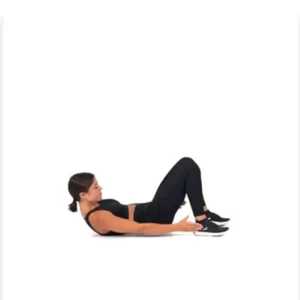
Mountain climber
The patient’s starting position is with a high plank position with the entire body straight & your hips joint level. Raise the patient’s right foot & draw your right knee toward your chest part in between both hands. Support the patient’s core tight & try not to hike the patient’s hip joint. As you back the patient’s right leg to plank, raise your left foot & draw your left knee to your chest between your both hands. Continue to alternate legs as fast as possible for 20-30 sec.

Pelvic tilt
The patient’s position is to lie on his/her back with knees bent. They gently rock your pelvis upwards & flatten your back into the bed or ground.
Note: You should feel abdominal muscles tighten a little
swing then return to the starting position and repeat. Aim for 5 repetitions 2 to 3 times a day in the first few weeks.
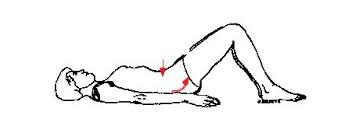
Heel slides
The patient’s position is to lie down on the ground or the bed with their legs flat. Gradually start to slide one heel toward your but, maintaining your heel on the ground or the bed. Your knee will start to flex.
Note: Continue to slide your heel & flex the knee until it becomes a little uncomfortable and you can feel a small amount of pressure inside the knee.
Hold this position for about 5 seconds. Slide your heel back down until the leg is straight on the ground or bed. Aim for 5 repetitions before swapping to the opposite side.

Twisting Sit-Ups
The patient’s position is to lie on her back and flex her knees to a comfortable position.
Lock your fingers behind your head, curl your head, shoulders, and upper & lower back off the ground & angle your left elbow toward your right knee.
Breathe out as you lift, and maintain this position for 5 sec.
Slowly back to starting position.
Curl your head, shoulders, and upper and lower back off the floor, and angle your right elbow toward your left knee
Maintain this position for 5 sec, and breathe out as you raise
slowly back to starting position, and repeat 10 more times alternating your twisting movement.

Hip Lift
The patient’s position is to lie on her back with her knees flexed. Very gently tilt your pelvis backward & tighten your pelvic ground muscles.
Raise but off the bed or the ground and slowly lift, vertebrae by vertebrae. Raise your but as high as you comfortably can
Maintain this position for 5 to 10 seconds, taking deep breaths. slowly lower your spine & pelvis back down, aim for 3 to 5 repetitions, building up to 10 to 15 repetitions in time & lifting higher as you continue to progress in your healing.
Abdominal Curl-ups
The patient’s position lies on your back with your knees flexed and both feet planted on the ground or the bed. Keeping your knees together, place your hand on both thighs.
Raise your head and shoulders off the ground by sliding your hands along your thighs towards your knees. Once you’ve reached a comfortable place, maintain this position for 3 to 5 sec, and slowly lower your head and shoulders back to the ground. Aim for 5 repetitions initially, building up to 10 to 15 repetitions in time & extending farther as continue to progress in your recovery.

Scissor
The patient’s position is lying down and face up with the patient’s hands behind the patient’s head and the patient’s head and shoulders raised off the base region. Using your abs, lift one leg slightly off the ground and scissor kick with your right leg up & left leg down. Change your legs for 20-30 seconds, and do not strain your neck area or just your chin forward.
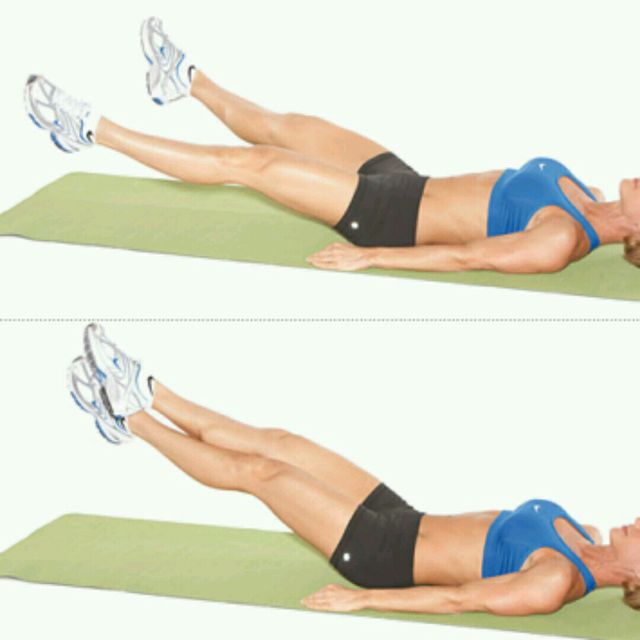
Slider pike
Grab some sliders, coasters, or towels to place under your both feet. The patient’s position is in a high plank position with both feet on the slider part then Squeeze your low abs & pull your feet in toward your both hands, raising the hip joint toward the roof into a pike position. Slowly push the patient’s feet out to lower your back site into the initiating position. Repeat this exercise for 30 sec every day.

Straight leg raise
The patient’s position is lying down face up with the patient’s arms to the sides & hands against the base area. Brace your core & lift straight legs slowly off the base, and bringing them to 90 degrees angle. Gradually lower your legs back to the base. Repeat this exercise for 30 seconds every day.
Note: If the patient has pain in her lower back region, then do not make this exercise, or try this pull-up bar variation instead.
Variation:
The patient’s position is holding a pull-up bar, bracing the core, and lifting the patient’s legs off the base to hip height. (initially, you could flex their knees; advanced exercisers could keep their legs straight and hinge at the hip joint for more of a challenge). Slowly lower the patient’s legs to the starting position and repeat this exercise for 30 seconds every day.
Crunches
Abdominal crunches are a significant way to strengthen your core muscles without placing too much stress on the lower back and spine.
For this exercise, the patient’s position is lying on the back, then flexing the knees to a comfortable position.
Lock your fingers behind the head or cross your arms in front of your chest and curl your head, shoulders, & upper back off the ground, and keep the lower back in contact with the ground; you should only rise a few inches.
Maintain this position for 30 seconds and slowly back to starting position.
Repeat this exercise 10 more times.
If you feel any back discomfort while you are performing the crunch, you must stop & check in with your healthcare provider or physiotherapist.
Cross-body climber
The patient’s position is to start in the high plank position with your body straight, the hips level, & the core braced. Raise your right leg & draw your right knee toward your left elbow. As you back one leg to the plank, lift your left leg and draw your left knee toward your right elbow. Continue to change legs and repeat this exercise for 30 seconds.
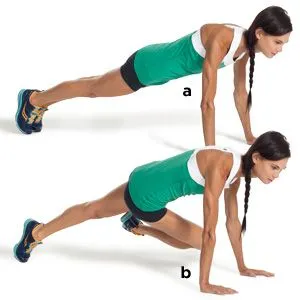
Exercise ball variation
If the patient has an exercise ball handy, try this variation instead:
The patient’s position is in a plank position with their feet on the ball, and keeping the patient’s core engaged, draw both knees in toward the chest.
And slowly extend the legs to return to the starting position, and repeat this exercise for 30 seconds every day.
Rolling plank
The patient’s position is in a low plank position propped up on the forearms. Then hold for 10 seconds. Roll onto the right elbow, stacking the patient’s feet. Maintain the side plank for 10- 20 seconds, engaging your obliques. Roll back through the middle & onto the patient’s left elbow, stacking your feet. Maintain for 10-20 seconds. Continue to alternate, keeping your core engaged & not letting the hip joint drop, for 20-30 seconds every day.
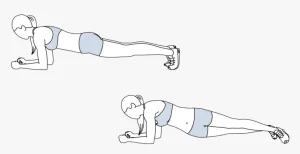
Roll up
The patient’s position is lying down face up with the patient’s legs extended, knees together, feet bent, & arms straight overhead. Take a big inhale. As you exhale, raise the patient’s arms up & forward & use your abs to slowly roll up to a sitting position. Drawing your abs in, slowly lower return to the starting position, and repeat as many times as can in 30 seconds every day.
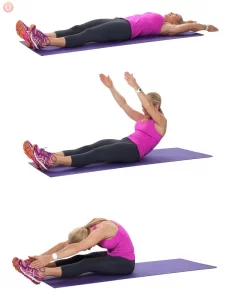
Jackknife
The patient’s position is to lie down faceup with the legs extended, feet together, & arms lifted straight overhead. Then Inhale. As you exhale, squeeze the abs & raise the patient’s right arm and left leg, touching the hand to foot. Inhale & slowly lower return to the starting position and lie down with your face up. Repeat for 15-20 seconds, then repeat on the other side for 15-20 seconds every day.
FAQ
How to treat lower abdominal muscle pain?
Alternate between using an ice pack and warm compresses for the injured region. Meet with a physiotherapist to know stretching & strengthening exercises. Take nonsteroidal anti-inflammatory drugs (NSAIDs) to reduce pain & inflammation. Wear an abdominal brace to support the stomach muscles & underrate swelling.
Is abdominal muscle pain serious?
Abdominal pain has many probable causes. The most common causes such as gas pains, indigestion, or a pulled muscle generally aren’t serious. Other conditions may need urgent medical attention.
How long does it take time for a lower abdominal muscle to heal?
Your healthcare provider may suggest stretching & strengthening exercises & other types of physical therapy to help you heal. A mild strain may recover within a few weeks. A more extreme strain may take 6 weeks or longer.
What causes lower abdominal muscle pain in females?
Other causes of lower abdominal pain include ovarian cysts, fibroids, irritable bowel syndrome (IBS), pelvic congestion syndrome, urinary tract infections, appendicitis & inflammatory bowel diseases, such as Crohn’s & ulcerative colitis.


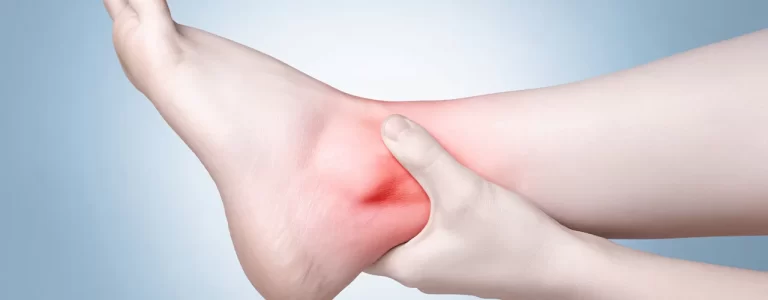
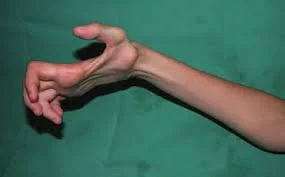

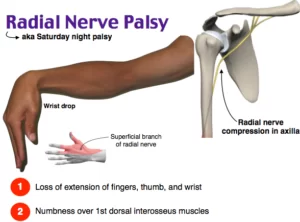


One Comment